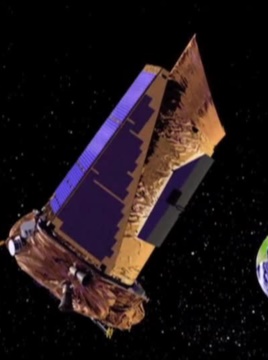VOA常速英语:美国国家航空航天专注于寻找类似地球的行星
VOA Standard English :NASA Focuses on Earth-Like Planets
For decades, looking for life elsewhere in the universe meant listening for signals that could be from distant civilizations. But recent breakthroughs in space technology refocused some of that effort toward finding planets that may harbor life, even in its primitive form.
When NASA launched the Kepler Space Telescope in 2009, scientists learned something new - and quite significant, says the director of the Space Telescope Science Institute, Matt Mountain.
“Our galaxy has at least 100 billion planets in it.
And we didn't know that five years ago," said Mountain.
Of course, Kepler and today's other powerful telescopes cannot actually see those planets; they are too faint against the light of their stars.
 |
But scientists can measure the change of light when they pass in front of the star and analyze the light passing through their atmosphere to determine what is in it.
“Well, if we were looking at Earth, we would see signs of our sky, our blue sky, we would see signs of oxygen, of carbon-dioxide, of sulfur dioxide from volcanoes and we might even see signatures that there was plant life," said NASA's astrophysicist and former astronaut John Grunsfeld. "And we see that by dissecting the light into its component colors."
Most of the planets discovered so far are unlike Earth. They are too big, too small, too close to their sun, or too far away to support life. But astrophysicist Sara Seager says small planets the size of Earth are extremely common.
“We're looking for biological signatures, gasses that are produced by life, gasses that don't belong in the atmosphere," said Seager.
In cooperation with the European Space Agency and scientists from other nations, NASA is building the next generation of space telescopes that may be able to find evidence of life.
The James Webb Space Telescope, scheduled to be deployed in 2018, will have unprecedented sensitivity and resolution that will greatly improve the spectroscopic analysis of distant stars and planets.
NASA’s chief scientist Ellen Stofan says the agency also plans to look for life on Jupiter’s moon Europa, which may have an ocean under its ice cover.
“In our own solar system we know where to go, we know what to measure it and we're in the process of doing just that. Looking out, beyond our solar system, we're on the right track, we're making the right measurements and we're just on the cusp of learning so much," said Stofan.
Scientists say there's a very high probability that they will find a planet very much like Earth. That could help answer the question: how hard is it for life to get a foothold in the universe?
- 频道推荐
- |
- 全站推荐
- 推荐下载
- 网站推荐




















